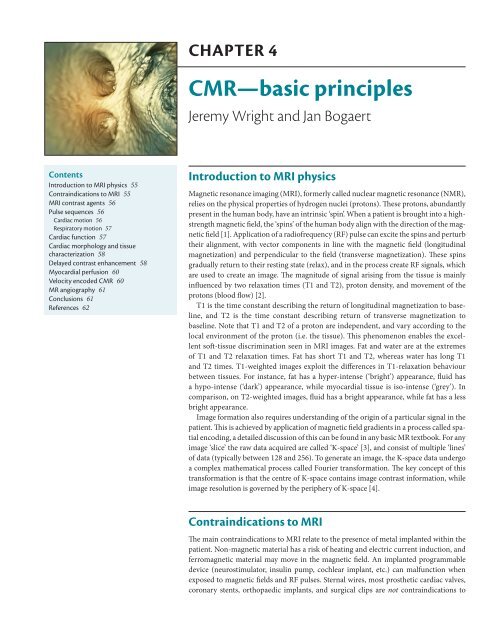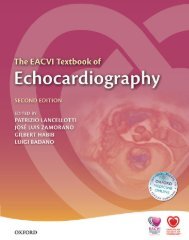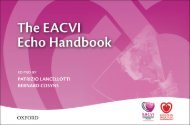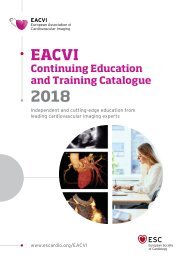ESC Textbook of Cardiovascular Imaging - sample
Discover the ESC Textbook of Cardiovascular Imaging 2nd edition
Discover the ESC Textbook of Cardiovascular Imaging 2nd edition
Create successful ePaper yourself
Turn your PDF publications into a flip-book with our unique Google optimized e-Paper software.
Chapter 4<br />
CMR—basic principles<br />
Jeremy Wright and Jan Bogaert<br />
Contents<br />
Introduction to MRI physics 55<br />
Contraindications to MRI 55<br />
MRI contrast agents 56<br />
Pulse sequences 56<br />
Cardiac motion 56<br />
Respiratory motion 57<br />
Cardiac function 57<br />
Cardiac morphology and tissue<br />
characterization 58<br />
Delayed contrast enhancement 58<br />
Myocardial perfusion 60<br />
Velocity encoded CMR 60<br />
MR angiography 61<br />
Conclusions 61<br />
References 62<br />
Introduction to MRI physics<br />
Magnetic resonance imaging (MRI), formerly called nuclear magnetic resonance (NMR),<br />
relies on the physical properties <strong>of</strong> hydrogen nuclei (protons). These protons, abundantly<br />
present in the human body, have an intrinsic ‘spin’. When a patient is brought into a highstrength<br />
magnetic field, the ‘spins’ <strong>of</strong> the human body align with the direction <strong>of</strong> the magnetic<br />
field [1]. Application <strong>of</strong> a radi<strong>of</strong>requency (RF) pulse can excite the spins and perturb<br />
their alignment, with vector components in line with the magnetic field (longitudinal<br />
magnetization) and perpendicular to the field (transverse magnetization). These spins<br />
gradually return to their resting state (relax), and in the process create RF signals, which<br />
are used to create an image. The magnitude <strong>of</strong> signal arising from the tissue is mainly<br />
influenced by two relaxation times (T1 and T2), proton density, and movement <strong>of</strong> the<br />
protons (blood flow) [2].<br />
T1 is the time constant describing the return <strong>of</strong> longitudinal magnetization to baseline,<br />
and T2 is the time constant describing return <strong>of</strong> transverse magnetization to<br />
baseline. Note that T1 and T2 <strong>of</strong> a proton are independent, and vary according to the<br />
local environment <strong>of</strong> the proton (i.e. the tissue). This phenomenon enables the excellent<br />
s<strong>of</strong>t-tissue discrimination seen in MRI images. Fat and water are at the extremes<br />
<strong>of</strong> T1 and T2 relaxation times. Fat has short T1 and T2, whereas water has long T1<br />
and T2 times. T1-weighted images exploit the differences in T1-relaxation behaviour<br />
between tissues. For instance, fat has a hyper-intense (‘bright’) appearance, fluid has<br />
a hypo-intense (‘dark’) appearance, while myocardial tissue is iso-intense (‘grey’). In<br />
comparison, on T2-weighted images, fluid has a bright appearance, while fat has a less<br />
bright appearance.<br />
Image formation also requires understanding <strong>of</strong> the origin <strong>of</strong> a particular signal in the<br />
patient. This is achieved by application <strong>of</strong> magnetic field gradients in a process called spatial<br />
encoding, a detailed discussion <strong>of</strong> this can be found in any basic MR textbook. For any<br />
image ‘slice’ the raw data acquired are called ‘K-space’ [3], and consist <strong>of</strong> multiple ‘lines’<br />
<strong>of</strong> data (typically between 128 and 256). To generate an image, the K-space data undergo<br />
a complex mathematical process called Fourier transformation. The key concept <strong>of</strong> this<br />
transformation is that the centre <strong>of</strong> K-space contains image contrast information, while<br />
image resolution is governed by the periphery <strong>of</strong> K-space [4].<br />
Contraindications to MRI<br />
The main contraindications to MRI relate to the presence <strong>of</strong> metal implanted within the<br />
patient. Non-magnetic material has a risk <strong>of</strong> heating and electric current induction, and<br />
ferromagnetic material may move in the magnetic field. An implanted programmable<br />
device (neurostimulator, insulin pump, cochlear implant, etc.) can malfunction when<br />
exposed to magnetic fields and RF pulses. Sternal wires, most prosthetic cardiac valves,<br />
coronary stents, orthopaedic implants, and surgical clips are not contraindications to





